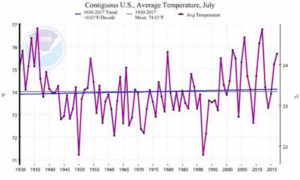Opinion: Analyzing climate change through the media
By Charlee Smith
Templeton, Calif.
Our climate has warmed by 1.5 degrees Fahrenheit in the past 100 years. Has the increase in CO2 levels from 302 ppm to 402 ppm during this period been a significant factor? Yes, but so have natural causes and other human activities. To illustrate the nature of the increase in carbon dioxide, if the components that make up our atmosphere are represented by $100, the amount of CO2 in 1917 was 3 cents. Today it is 4 cents. Even this small amount, however, is a factor in the greenhouse effect, a reality that many skeptics must learn to accept.
What puts me in the skeptic category of the global warming issue, however, are the exaggerated predictions that we see almost every day in the media. Many climate change alarmists are taking cherry-picked evidence to justify radically changing our way of living, usually at a very high cost. Developing nations are tagging along since some proposals would have industrialized nations financially compensate them. The good news is that cooler heads are prevailing. CO2 emissions here in the U.S. have been decreasing since 2007, with a 3 percent drop in 2016. Regulations are in place to continue this trend at a reasonable cost.
I’m a true believer in science, but scientists are human. Skepticism is necessary, like in most aspects of life, to prevent the implementation of unwarranted solutions. The facts that I drive a hybrid and will have solar panels at my house next month are a consequence of the purchases making environmental and economic sense, and not due to extremist’s dire predictions that has activists yelling “We’re all going to die!” and “Due to climate change my kid’s very existence is in danger”.
My questioning of scientific consensus is strongest when I hear the statement, “Due to human actions, storms are worse than they have ever been”. The whole truth is that six of the seven deadliest storms in history occurred before 1895. Each of these storms killed more than 200,000 people when the earth’s population was a fraction of what it is today. In addition, the U.S. mainland has not been hit by a hurricane of greater than Category 2 for over 11 years, something that has not happened before in U.S. history. This is contrary to the majority of predictions by climate scientists, some who now say climate change has formed a cold water/wind shear barrier along much of our coastline that defuses these storms.
One of the ironies of the climate issue is that the tremendous progress we have made to clean our air since 1970 has also had a significant impact on rising temperatures. Cleaner air reflects less heat from our sun back into space. In the U.S. we have gone from an average temperature of 50.8 degrees Fahrenheit in 1979 to 54.8 degrees Fahrenheit in 2016. What most climate authorities won’t tell you, however, is that our average temperature went from 50.2 degrees Fahrenheit in 1917 to 54.2 degrees Fahrenheit in 1934, the same 4 degrees Fahrenheit increase.
Much of the climate data released by scientists show graphs which depict temperature anomalies compared to a baseline period of time. The most commonly used time period is 1951-1980, which had a mean temperature of 51.87 degrees Fahrenheit and conveniently had a 0.69 degrees Fahrenheit decrease in average temperature. During these same 30 years, CO2 levels went from 312 ppm to 339 ppm. If a different time period was used for the baseline, say 1925-1954, its mean temperature was 52.26 degrees Fahrenheit, which would result in the anomalies decreasing by 0.39 degrees Fahrenheit. I can’t help but conclude that 1951-1980 was chosen so that the results were skewed to maximize their impact. Most climate activists are not even aware of how hot the 1930s were since they have never been told the whole truth, and probably never looked for it.
Last month was a hot one. Is it more evidence that climate change will devastate our planet? This NOAA graph of July temperatures from 1930 to 2017 tells a different story:

NOAA graph of July temperatures 1930 to 2017
Like just about everything in life, the extremes of most issues are very easy to criticize. Climate activists are influenced by an extremely powerful drug: the feeling they are saving the planet. Many on both sides of the global warming issue will only observe and believe what they want to believe. The name calling and disrespect that fills our media needs to end. We are already on the path to a bright future, but must remain skeptical to unwarranted proposals and solutions.






















